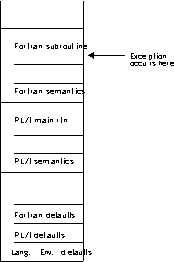Exception occurs in Fortran
This scenario describes the behavior of an application that contains a Fortran and a PL/I routine. Refer to Figure 1 throughout the following discussion. In this scenario, a PL/I main routine invokes a Fortran subroutine. An exception occurs in the Fortran subroutine.
Figure 1. Stack contents when the exception
occurs in Fortran

The actions taken follow the three Language Environment condition handling steps: enablement, condition, and termination imminent.
- If an I/O error is detected on a Fortran I/O statement that contains an ERR or IOSTAT specifier, Fortran semantics take precedence. The exception is not signaled to the Language Environment condition handler.
- In the enablement step, Fortran treats all exceptions as conditions. Processing continues with the condition handling step.
- There is no user-written condition handler on the Fortran stack frame (because CEEHDLR cannot be called from a Fortran routine), and the condition is percolated.
- If a user-written condition handler has been registered on the PL/I stack
frame using CEEHDLR, it is given control. If it issues a resume, the
condition handling step ends. Processing continues in the routine
at the point where the resume cursor points.
In this example, no user-written condition handler is registered for the condition, so the condition is percolated.
- If an ON-unit has been established for the condition being processed on the PL/I stack frame, it is given control. If it issues a GOTO out-of-block, the condition handling step ends. Execution resumes at the label of the GOTO. In this example, no ON-unit is established for the condition, so the condition is percolated.
- What happens next depends on whether the condition is promotable
to the PL/I ERROR
condition. The following can happen:
- If the condition is not promotable to the PL/I ERROR condition, then the Language Environment default actions take place, as described in Table 1. Condition handling ends.
- If the PL/I default action for the condition is to promote it to the PL/I ERROR condition, The condition is promoted, and another pass of the stack is made to look for ERROR ON-units or user-written condition handlers. If an ERROR ON-unit or user-written condition handler is found, it is invoked.
- If either of the following occurs:
- An ERROR ON-unit or user-written condition handler is found, but it does not issue a GOTO out of block or similar construct
- No ERROR ON-unit or user-written condition handler is found
- If no condition handler moves the resume cursor and issues a resume, Language Environment terminates the thread.